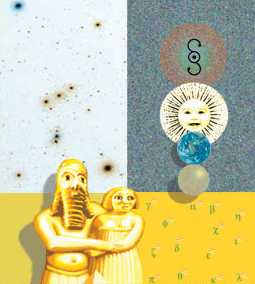Before humankind had telescopes and complex religio-scientific explanations for the affairs in the sky, there was a more natural, inquisitive and (perhaps) more realistic view of the cosmos. By re-considering essential ideas still surviving from pre-history (now in a highly confused state called Astrology), and applying straight-forward observational information, we can re-assess our relationship with the Sun, Moon and planets. Before it is too late.

1 Astronomy as quiet observation
It has been a long time since astrologers and astronomers have sat quietly, outside, watching and experiencing the cosmologies they describe. It is easy for scientists and other theorizers to forget that the Earth, Moon, planets, Sun and stars are not abstract objects, but function as part of a grand physical scheme that human minds cannot fathom easily. And the growing understanding that Life is not just about DNA suggests that these enormous things are enormously endowed with Life. It is just for us to discover how and why.
The book Sky Knowledge wonders about this, and offers a fresh view of our place in the local cosmos. This in turn opens up a fresh avenue of enquiry into what is usually called astrology. In any case whatsoever, it should be in our interest to take notice of the local celestial situation, as it unfolds.
2 Current state of the system
We have a good idea where the Sun is in the sky. How about the Moon – do we notice the lunar being these days? And as for the planets, could we be sure of finding any one of them in the night sky? Apart from the current lack of awareness of celestial activities, we are still lucky that planetary locations can be calculated, and we can access the information in an almanack.
Such information can be accessed via the forms below. Basically an online almanack, its content is rich yet compact and clear. Most importantly, all information is calculated with only one (correct) presumption: the Sun is the focus of our solar system.
Note: data is for 12:00 GMT unless otherwise stated. This means that for an observer in say timezone +10 (Australia), the data is for 22:00 (10pm), and so on.
2.1 The Moon
For the closest celestial object—fascinating since at least the dawn of humankind—the following information is available:
- geocentric sign (for 00:00 and 12:00 GMT)
- nakshatra ( " )
- geocentric equatorial & ecliptic latitudes
- progress – heading nearer to, or further from the Earth
- aspect to Sun, ie. phase (for 00:00 and 12:00 GMT)
- image of lunar phase (northern hemisphere view)
- aspects to planets (the lunar resonances)
- month name – ultimately derived from lunar signs
- month’s date, a number derived from the lunar orbit
2.2 Earth and the other planets
The almanacks available here are heliocentric, with the solar system seen from the point of view of the Sun. The Earth is just one of many planets, and all are held in extraordinary balance by the solar “parent”. Note that the heliocentric signs given are a few degrees different from traditional astrological signs (even after coordinate transformation), being aligned to important points of the Sun’s own orientation. For each planet, the following information is available:
- heliocentric sign
- heliocentric latitude
- progress – heading nearer to, or further from the Sun
- local season in northern hemisphere
- heliocentric aspects with the other planets
In addition to the status of the planets, some other information is included to fill out the picture:
- planetary system “balance” factor (the Gap)
- week-day name – ultimately derived from planet-related gods
- year’s day number, stepped along the Earth’s orbit
- time of culmination of the galactic center – the Sun’s orbital “parent”
The outer giants Uranus and Neptune have no heritage of traditonal study, being invisible to the naked eye. To simplify the almanacks presented here, and avoid having to rationalize the very slow and distant activity of these planets, they do not appear. Pluto and major asteroids were never part of this scheme.
2.3 More about the almanack data
2.3.1 Most people are familiar with the astrological signs, but here, until further notice, they simply refer to sectors of the ecliptic, each 30 degrees in range. In the almanack, these are further subdivided into three, hence the numeric label found attached to the astronomical abbreviation.
Begins Name 0° Ari Aries 30° Tau Taurus 60° Gem Gemini 90° Cnc Cancer 120° Leo Leo 150° Vir Virgo 180° Lib Libra 210° Sco Scorpio 240° Sgr Sagittarius 270° Cap Capricorn 300° Aqr Aquarius 330° Psc Pisces
2.3.2 In the Indian tradition, the lunar orbit was divided into 27 nakshatras, each loaded with a personality which applied when the Moon entered that sector of the sky. Again, in the almanack they are shown subdivided into three.
2.3.3 A new concept introduced in the Astro-Logical Almanacks is that of orbital progress. This is simply about whether the orbiting body (in its elliptical orbit) is getting further away or closer to the parent body. The implication is that the “warmest” state for the orbiting body is when it is nearest the parent, and, as for a child, that may also be the most comforting. This happens at PERI, whilst the remotest, “coolest” point is AP.
2.3.4 The aspect of one planetary body to another is simply the angle between them. Since the early days of traditional astrology, some angles have held more significance than others. Here, the aspects have been simplified, and the most important geometrical alignments are written in capitals: CONJ, SQR and OPP, for zero, 90 and 180 degrees respectively.
2.3.5 One of the most significant points in the sky, being the focus of the Sun’s own orbit, is the Galactic Center. It is located at the edge of Sagittarius. In the almanack, the local time of the culmination of § is shown. This is simply when that point is at its highest in our sky. (It is accurate to within a few minutes anywhere on Earth.)
2.3.6 Another new concept introduced in the Astro-Logical Almanacks is that of the gap. For this, the longitudes of each planet are added together as unit vectors, and the resultant vector is made negative. This represents a planetary body of weight units which would counter-balance the current configuration. (For this calculation, I include the outer giants Uranus and Neptune.) For example, if all eight planets were residing in the sector of Aries, the Sun’s “attention” is fully lopsided; a theoretical planet of weight=8 residing in Libra would then balance the Sun’s attention.
2.4 Get the state of the system
Or download data for the first half of 2013
(free PDF with week-to-a-view).
Or download data for the second half of 2013
( " ).
Or download data for the first half of 2014
( " ).
For other years and searching options, see below.
3 Analysis of the data
The overall vision which gives meaning and/or poignancy to the information presented in the almanacks is developed in full in Sky Knowledge. There is, however, next to no common or reliable history of interpretation of the celestial events as presented in the almanacks. The first reason for this is that we are using a heliocentric system, and such a system has been consistently ignored by astrologers even after it was verified by Copernicus and lauded by Kepler centuries ago.
The second reason has to do with ancient knowledge and symbolism imperfectly inherited. In countless ways, reinforced by fashionable ignorance and professional pride, the richness and directness of ancient perceptions has come down to us in a confused and near-useless set of formalized interpretations.
The third reason is that astronomy (a science) is the most respectable observer of the heavens nowadays, with extraordinary facilities and theories which nevertheless still confuse the average person. Importantly, science does not look for meaning.
|
Readers are therefore encouraged to act as pioneers in this new field of applied astronomy, by taking note of any perceived correspondences between the celestial situation and events (or feelings) in their lives. These observations may then be shared and accumulated via the Repository. In the meantime you can respond via the email address on the home page. |
4 Meaning in the sky
There is still, however, a great deal of traditional knowledge and hearsay which can be examined for inklings of meaning. The mere fact that ideas are passed down over long periods of time suggests they are powerful for some reason. And many of the ideas upon which astrology is based were already well-formed 5,000 years ago!
5 Almanack services
It will sometimes be useful to study the state of the solar system with analytical tools, or for periods other than days of the current year. Here are some services.
5.1 Heliocentric birth charts
Get a unique and attractive Certificate of Celestial Ambience showing the state of the solar system at the time of your birth. Fee is A$10.
5.2 Search with multiple aspect criteria
5.3 Astronomical data for any date
[Still to come, with a small fee per view.]
5.4 A year’s worth of data
[Still to come, a fee-based service.]

